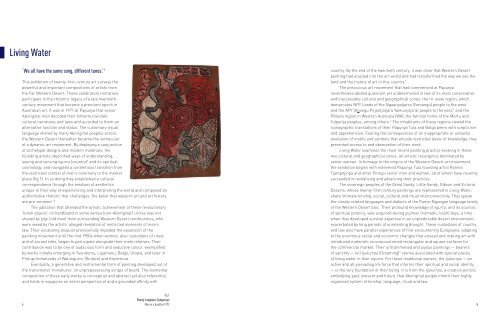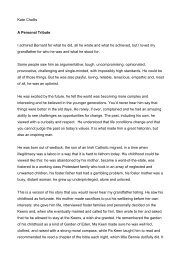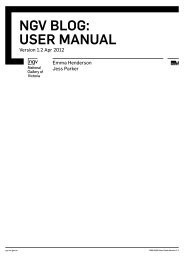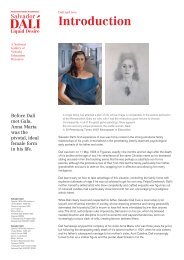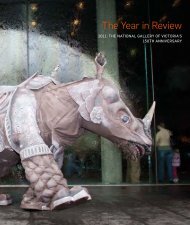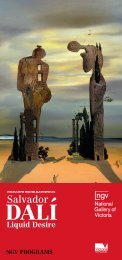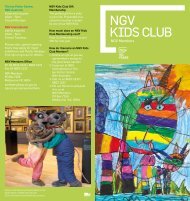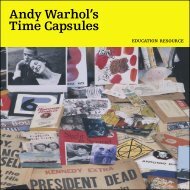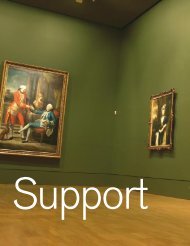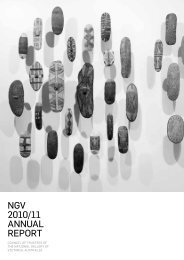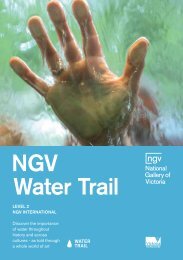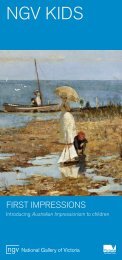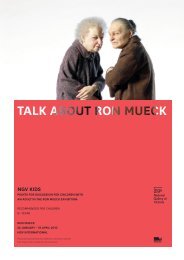Living Water: Contemporary Art of the Far Western Desert
Living Water: Contemporary Art of the Far Western Desert
Living Water: Contemporary Art of the Far Western Desert
Create successful ePaper yourself
Turn your PDF publications into a flip-book with our unique Google optimized e-Paper software.
<strong>Living</strong> <strong>Water</strong><br />
‘We all have <strong>the</strong> same song, different tunes.’ 1<br />
This exhibition <strong>of</strong> twenty-first-century art surveys <strong>the</strong><br />
powerful and important compositions <strong>of</strong> artists from<br />
<strong>the</strong> <strong>Far</strong> <strong>Western</strong> <strong>Desert</strong>. These celebratory narratives<br />
participate in <strong>the</strong> rhizomic legacy <strong>of</strong> a late twentiethcentury<br />
movement that became a prescient epoch in<br />
Australian art. It was in 1971 at Papunya that senior<br />
Aboriginal men decoded <strong>the</strong>ir hi<strong>the</strong>rto inviolate<br />
cultural narratives and laws and accorded to <strong>the</strong>m an<br />
alternative function and status. The customary visual<br />
language shared by many Aboriginal peoples across<br />
<strong>the</strong> <strong>Western</strong> <strong>Desert</strong> <strong>the</strong>reafter became <strong>the</strong> vernacular<br />
<strong>of</strong> a dynamic art movement. By deploying a conjunction<br />
<strong>of</strong> archetypal designs and modern materials, <strong>the</strong><br />
founding artists objectified ways <strong>of</strong> understanding,<br />
seeing and sensing ngurra (country) 2 and its spiritual<br />
cosmology, and navigated a contentious transition from<br />
<strong>the</strong> restricted context <strong>of</strong> men’s ceremony to <strong>the</strong> market<br />
place (fig.1). In so doing <strong>the</strong>y established a cultural<br />
correspondence through <strong>the</strong> medium <strong>of</strong> aes<strong>the</strong>tics<br />
unique to <strong>the</strong>ir way <strong>of</strong> experiencing and interpreting <strong>the</strong> world and composed an<br />
authoritative rhetoric that challenges ‘<strong>the</strong> belief that western art and art history<br />
are pre-eminent’. 3<br />
The jubilation that attended <strong>the</strong> artistic achievement <strong>of</strong> <strong>the</strong>se revolutionary<br />
‘fetish objects’ on hardboard in some kartiya (non-Aboriginal) circles was not<br />
shared by tjilpi (old men) from surrounding <strong>Western</strong> <strong>Desert</strong> communities, who<br />
were vexed by <strong>the</strong> artists’ alleged revelation <strong>of</strong> restricted elements <strong>of</strong> men’s<br />
law. Their escalating disquiet provisionally impeded <strong>the</strong> expansion <strong>of</strong> <strong>the</strong><br />
painting movement until <strong>the</strong> mid 1980s when women, also custodians <strong>of</strong> ritual<br />
and <strong>of</strong> sacred sites, began to participate alongside <strong>the</strong>ir male relatives. Their<br />
contribution was to be one <strong>of</strong> audacious form and seductive colour, exemplified<br />
by works initially emerging in Yuendumu, Lajamanu, Balgo, Utopia, and later in<br />
Pintupi homelands <strong>of</strong> Walungurru (Kintore) and Kiwirrkura.<br />
Eventually, a generative and instrumental form <strong>of</strong> painting developed out <strong>of</strong><br />
<strong>the</strong> transitional ‘miniatures’ on unprepossessing scraps <strong>of</strong> board. The elemental<br />
composition <strong>of</strong> <strong>the</strong>se early works is conceptual and abstract yet also referential,<br />
and holds in equipoise an aerial perspective <strong>of</strong> and a grounded affinity with<br />
country. By <strong>the</strong> end <strong>of</strong> <strong>the</strong> twentieth century, it was clear that <strong>Western</strong> <strong>Desert</strong><br />
painting had erupted into <strong>the</strong> art world and had transformed <strong>the</strong> way we see <strong>the</strong><br />
land and <strong>the</strong> history <strong>of</strong> art in this country. 4<br />
The precocious art movement that had commenced at Papunya<br />
never<strong>the</strong>less abided quiescent yet undetermined in two <strong>of</strong> its most conservative<br />
and inaccessible cultural and geographical zones: <strong>the</strong> tri-state region, which<br />
demarcates NPY Lands <strong>of</strong> <strong>the</strong> Ngaanyatjarra (Yarnangu) people to <strong>the</strong> west<br />
and <strong>the</strong> APY (Anangu Pitjantjatjara Yankunytjara) people to <strong>the</strong> east; 5 and <strong>the</strong><br />
Pilbara region in <strong>Western</strong> Australia (WA), <strong>the</strong> familial home <strong>of</strong> <strong>the</strong> Martu and<br />
Yulparija peoples, among o<strong>the</strong>rs. 6 The inhabitants <strong>of</strong> <strong>the</strong>se regions viewed <strong>the</strong><br />
iconographic translations <strong>of</strong> <strong>the</strong>ir Papunya Tula and Balgo peers with scepticism<br />
and apprehension. Fearing <strong>the</strong> consequences <strong>of</strong> an inappropriate or unlawful<br />
revelation <strong>of</strong> motifs and symbols that encode restricted levels <strong>of</strong> knowledge, <strong>the</strong>y<br />
prevented access to and observation <strong>of</strong> <strong>the</strong>ir work.<br />
<strong>Living</strong> <strong>Water</strong> examines <strong>the</strong> most recent painting practice evolving in <strong>the</strong>se<br />
two cultural and geographical zones: an artistic resurgence dominated by<br />
senior women. In homage to <strong>the</strong> origins <strong>of</strong> <strong>the</strong> <strong>Western</strong> <strong>Desert</strong> art movement,<br />
<strong>the</strong> exhibition begins with esteemed Papunya Tula founding artist Ronnie<br />
Tjampitjinpa and o<strong>the</strong>r Pintupi senior men and women, all <strong>of</strong> whom have recently<br />
succeeded in revitalising and advancing <strong>the</strong>ir practices.<br />
The sovereign peoples <strong>of</strong> <strong>the</strong> Great Sandy, Little Sandy, Gibson and Victoria<br />
<strong>Desert</strong>s, whose twenty-first-century paintings are represented in <strong>Living</strong> <strong>Water</strong>,<br />
share intimate kinship, social, cultural and ritual interconnectivity. They speak<br />
<strong>the</strong> closely related languages and dialects <strong>of</strong> <strong>the</strong> Pama-Ngungan language family<br />
<strong>of</strong> <strong>the</strong> <strong>Western</strong> <strong>Desert</strong> bloc. Their pr<strong>of</strong>ound knowledge <strong>of</strong> ngurra, and its sources<br />
<strong>of</strong> spiritual potency, was acquired during pujiman (nomadic, bush) days, a time<br />
when <strong>the</strong>y developed survival expertise in an unpredictable desert environment,<br />
exacerbated by long periods <strong>of</strong> unrelenting drought. These custodians <strong>of</strong> country<br />
and law also have parallel experiences <strong>of</strong> first encountering Europeans, adapting<br />
to <strong>the</strong> enormous social and economic changes that ensued and making art with<br />
introduced materials on unaccustomed rectangular and square surfaces for<br />
<strong>the</strong> commercial market. Their untrammelled and joyous paintings — bearers<br />
<strong>of</strong> sanctity — tell tjukurrpa (Dreaming) 7 stories associated with special places<br />
<strong>of</strong> living water in <strong>the</strong>ir ngurra. For <strong>the</strong>se traditional owners, <strong>the</strong> tjukurrpa — an<br />
active and all-pervading life force that informs <strong>the</strong>ir spiritual and social identity<br />
— is <strong>the</strong> very foundation <strong>of</strong> <strong>the</strong>ir being. It is from <strong>the</strong> tjukurrpa, a creation period,<br />
embodying past, present and future, that Aboriginal people inherit <strong>the</strong>ir highly<br />
organised system <strong>of</strong> kinship, language, ritual and law.<br />
fig.1<br />
Shorty Lungkata Tjungurrayi<br />
4 Men in a bushfire 1972<br />
5
Roy Underwood<br />
Simon Hogan<br />
20 Mulaya 2008<br />
Ilkurlka 2004<br />
21


